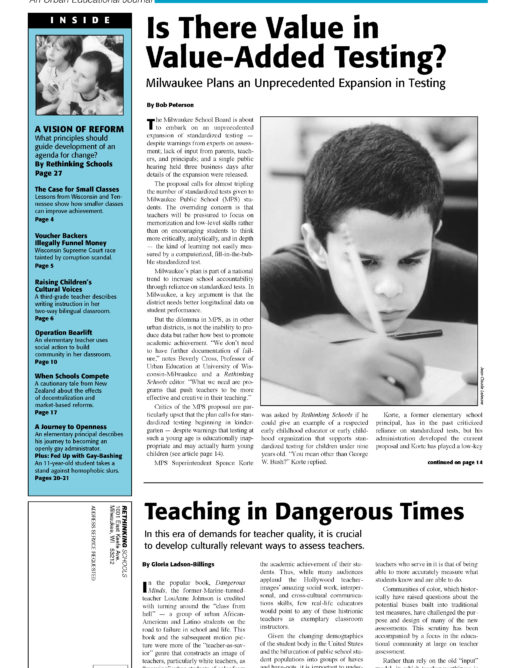Preview of Article:
The Educational Costs of Standardization
More testing might sound nice as a policy soundbite. But as Texas shows, the move toward high-stakes tests shortchanges learning in the classroom.
Teachers, even those who know their subjects and their students well, have much less latitude when their principals purchase test-prep materials to be used in lieu of the regular curriculum. The decision to use such materials forces teachers to set aside their own best knowledge of their subject in order to drill their students on information whose primary (and often sole) usefulness is its likely inclusion on the test. Examples of this splitting of personal and professional knowledge, and the requirement to do so, abound. A particular example reveals not only how test-prep “teaching” diminishes the role of the teacher but also how it distances course content from the cultures of the students.
One teacher, a graduate of an Ivy League college, with a master’s degree at another select college, had spent considerable time and money assembling a rich collection of historical and literary works of importance in Latino culture. She had sought titles especially related to the American Southwest for her classes at a Latino high school. Her building of a classroom resource collection was extremely important given the school’s lack of a library and its lean instructional budget. Her students responded to her initiative with a real enthusiasm to study and learn. She was dismayed to see, upon returning one day from lunch, that the books for her week’s lessons had been set aside. In the center of her desk was a stack of test-prep booklets with a teacher’s guide and a note saying “use these instead of your regular curriculum until after the TAAS.” The TAAS test date was three months away. (The prep materials bore the logo “Guerrilla TAAS,” as in making war on the TAAS test; the booklet covers were military-camouflage colors; the Guerrilla TAAS consultants came to the school in camouflage gear to do a TAAS pep rally for the students and faculty.) This teacher reported that her principal, a person dedicated to these students and to helping them pass the TAAS in order to graduate, had spent almost $20,000, virtually the entire instructional budget for the year, on these materials. The cost was merely one problem. Inside the booklets for “reading” were single-page activities, with brief reading selections followed by TAAS-type answer choices. These students, who had been analyzing the poetry of Gary Soto and exploring the generational themes in Bless Me ltima, had to set aside this intellectual work to spend more than half of every class period working through the TAAS-prep booklet.
The imposition throughout the entire school of TAAS prep as a substitute curriculum recast the role of teachers, making them into people needing outside consultants to tell them (and “pep them up for”) ways to raise test scores. That these commercial materials were imposed proscribed the capacity of the teacher to resist. They also made it difficult for teachers to make accommodations at the margins, to try to hold onto the more substantive curriculum and cultural connections the magnet teachers for the most part had managed under the proficiency system to do.
TEACHER CONSTRAINTS
The limiting of the role of the teacher in shaping or negotiating the course content and the means of assessment causes problems beyond deciding what to teach. When their students’ learning is represented by the narrow indicators of a test like the TAAS, the teachers lose the capacity to bring into the discussion of the school program their knowledge of what children are learning. Teachers in urban schools say that to raise questions about the TAAS and about artificial test prep is characterized as being against minority students’ chances to get high test scores. Or it is portrayed as “not being a team player.” The test scores generated by centralized, standardized tests like the TAAS, and by the test-prep materials which prepare them for those tests, are not reliable indicators of learning. It is here where the effects on low-performing students, particularly minority students, begin to skew the possibilities for their access to a richer education.
At this school and other minority high schools where TAAS prep is replacing the curriculum, teachers report that even though many more students are passing TAAS “reading,” few of their students are actually readers. Few of them can use reading for assignments in literature, science, or history classes; few of them choose to read; few of them can make meaning of literature or connect writing and discussing to reading. In schools where TAAS reading scores are going up, there is little or no will to address this gap. First, so much publicity surrounds the rising scores, and the principals’ and superintendents’ bonuses are contingent on that rise, that the problem of nonreaders is silenced. Second, with the problem silenced, there can be no leverage to add the resources, change the teaching, or invite discussion about the sources of the problem. In fact, the opposite occurs: the rise in scores is used to justify even more TAAS prep, even more pep rallies, even more substituting of test-based programs for the regular curriculum.

